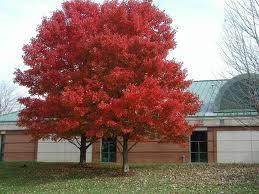I visited your property and looked at your tree. Your tree is a red maple and there were several items immediately evident:
1. There are plenty of buds on the tree. They may not be easy to see because they have not begun to swell as they will in the spring.
2. Someone has recently climbed the tree using gaffs and cut off several upper branches. The use of gaffs on a tree instead of a ladder or rope is not recommended because they open wounds in the cambium that permit disease to enter and stress the tree.
3. There are other cuts made to the branches that appear to be approximately 5 years old that have not compartmentalized properly as they would in a healthy tree.
4. The picture you had me review shows your tree with early fall coloration on only one side of the tree. This is a classic indication of what is called “Maple Decline”.
5. Your tree does not have the usual basal trunk flare and buttress roots at the soil line.
6. There is some loose bark at the base of the tree and evidence of some insect invasion of the cambium layer of the tree as a result of stress caused by the two conditions.
The first condition I observed is Fungal Collar Rot, which is evidenced by the early fall coloration on only one side of the tree. This is the tree’s defense mechanism permitting the tree to go dormant early to save energy through the winter for the healthy parts of the tree. The second condition that is evident is ‘Girdling Root’, which is choking off nutrients to the tree preventing it from fighting off the fungi.
Suggestions:
Your tree is not showing severe symptoms of decline and can be treated with a fungicide and fertilizing. Watering the tree during dry periods may restore the tree’s vigor and delay further decline. Your tree should receive at least an inch of water across the root base each week during a dry period. Treating your tree after the soil warms this spring would be advised. We would be happy to send you an estimate and put you on our schedule.
